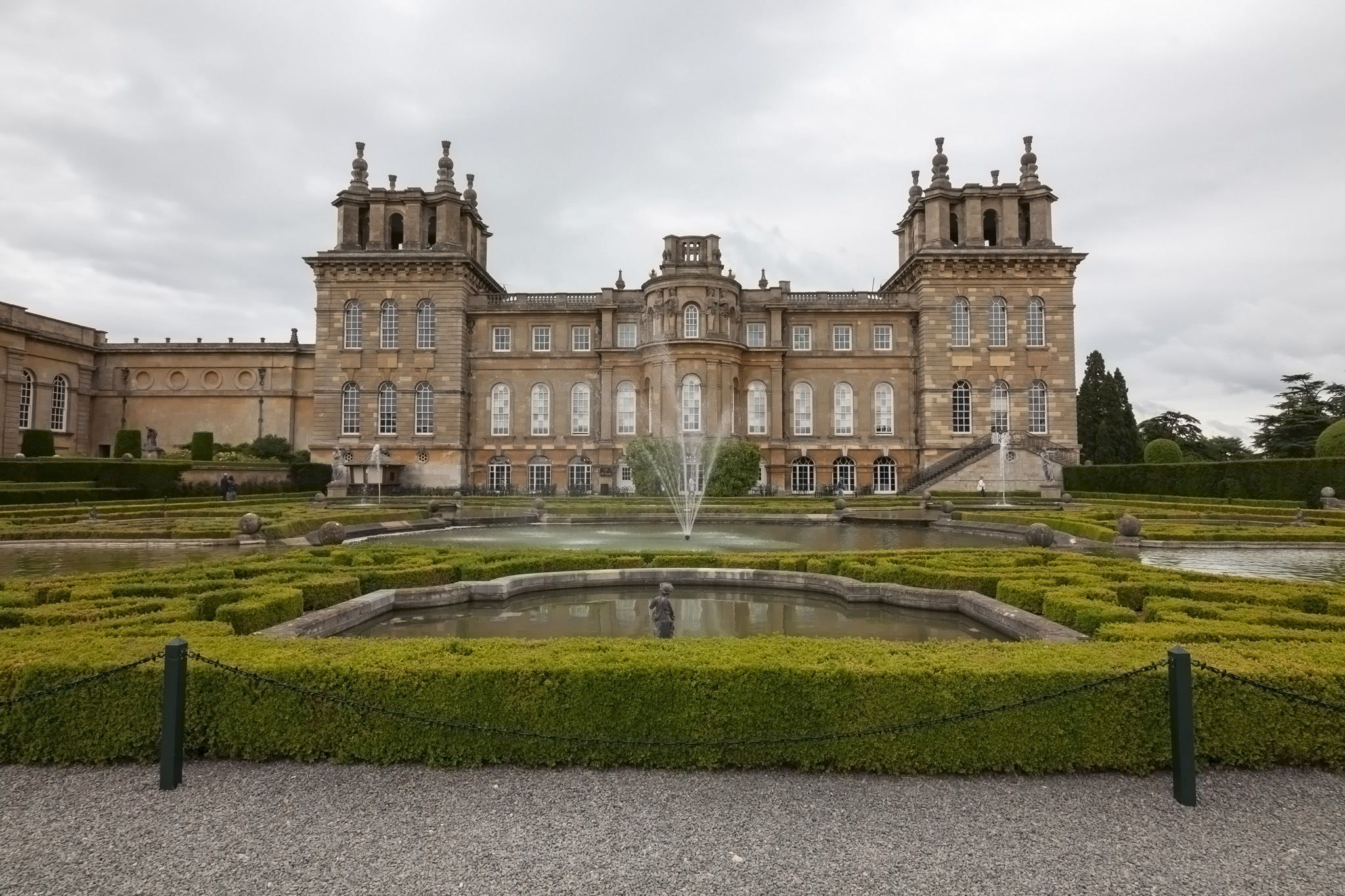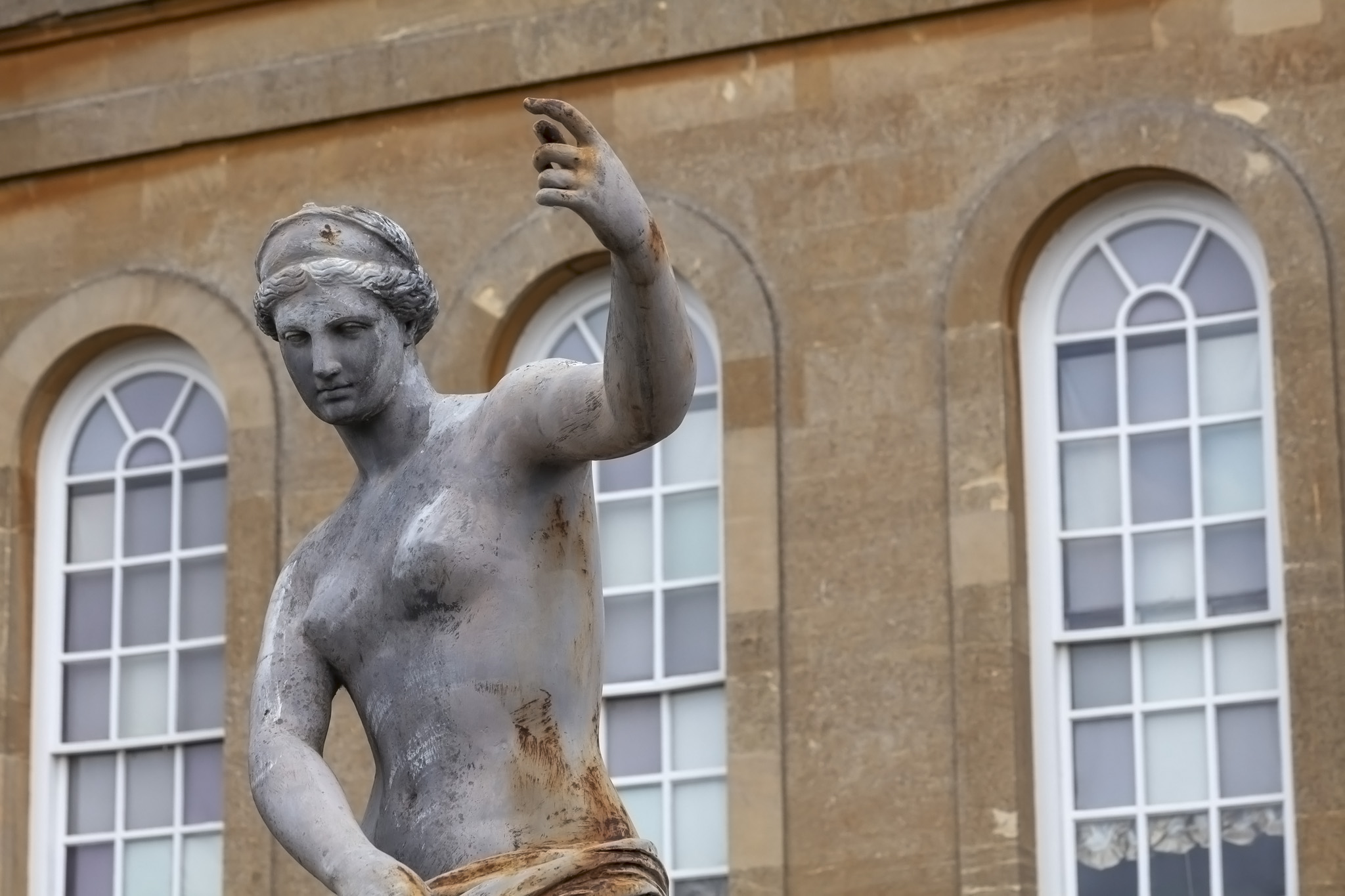My wife’s cousin lives in Oxfordshire so on one occasion in 2011 we combined a visit to see him and his wife with a side-trip to take a look at Blenheim Palace, somewhere we’d seen signposted every time we’d dropped into the area but which we’d never thought to actually make the time for.
Although it’s called a palace it’s really just a country house, albeit one on a huge scale and with sprawling grounds and gardens to explore. At the time of our visit it wasn’t possible to take photographs inside the building itself so the pictures accompanying this post will simply cover the exterior spaces.
After you’ve parked your car there is a walk of around two hundred metres until you reach the East Courtyard where you can find the ubiquitous tourist attraction souvenir shop. Proceeding through that courtyard you then reach the main courtyard and main views of the building. Built in the very early part of the eighteenth century in the not-very-well-known and short-lived English Baroque style, Blenheim was designed by Sir John Vanbrugh and intended as a reward for military successes against the French by the First Duke of Marlborough whose family name of Churchill (later Spencer-Churchill) you’ll likely be familiar with. Indeed, Winston Churchill was born in Blenheim Palace.
We briefly headed away from the palace building where a long road stretched out ahead, crossing over the River Glyme and leading towards a distant monument. After consulting the map we had at the time we ultimately decided not to make the walk to see what was in the distance but if we had then we would have discovered that it was the Column of Victory and the wording on its base (source: Wikisource) reads:
Most Gracious Sovereign, Whereas the Eminent and Unparalleled Services Performed to Your Majesty and the Crown of ENGLAND by the most Noble IOHN Duke of MARLBOROUGH are well known not only to Your Majesty and all Your Subjects but to all EUROPE, who will always Remember That the Alliances which Your Majesty’s Royal Brother King WILLIAM the Third of Glorious Memory, had, in a little time before His Death Contracted by the Ministry of the said Duke of MARLBOROUGH as His Majesty’s Ambassador Extraordinary and Plenipotentiary to the STATES-GENERAL of the United-Provinces for Preserving the Liberties of EUROPE against the Ambition of FRANCE, were immediately after Your Majesty’s Happy Accession to the Throne by the said Duke, then Imployed by Your Majesty in the same Character, Confirmed and Improved, and others were Contracted, whereby the Confederacy which had been Dissolved at the End of the last War, was Reunited in a Stricter and Firmer League; And that in the First Year of Your Majesty’s Reign, the said Duke of MARLBOROUGH did so well execute the Commission and Orders which He received from Your Majesty as Captain-General and Commander in Chief of Your Majesty’s Forces, That He not only Secured and Extended the Frontier of HOLLAND by Taking the Towns and Fortresses of VENLO, RUREMOND, STEVENSWAERT and LIEGE, but soon obliged the Enemy (who had been at the Gates of NIMEGHEN) to seek Shelter behind their Lines.
Yes, so let’s not hear any more crap about me writing long, run-on sentences on this site any more, okay?
There is another reason to head towards the column, though, and that is that just beyond the bridge, among the trees to the left, there is a tree called the Harry Potter Tree as it featured in one of the films. If you’re a fan of the franchise of books or movies then you might enjoy the experience of seeing it in real life but we didn’t know about it at the time and sufficed ourselves with some simple landscape views from near the courtyard gates.
We headed back to the main building of Blenheim Palace and me being me, photos were taken. The weather during our visit threatened to rain for the entire time but never quite managed it, thankfully.
As stated near the top of this post we weren’t able to take pictures inside the palace during our visit but as we entered through the main portico we noticed some highly unusual artwork adorning the ceiling: three blue eyes and three brown eyes. These were at the behest of the second wife of the ninth Duke of Marlborough and their combined history as it pertains to Blenheim Palace is very interesting indeed.
The ninth duke was Charles Spencer-Churchill who inherited Blenheim and his title in 1892 at a time of near-bankruptcy for the estate. His solution to those financial problems was to marry into money, and the wealthy Vanderbilt family liked the idea of having a duchess in the family so a marriage of not-quite-convenience was enforced upon Consuelo Vanderbilt. There was no love in the union even though it did produce two sons (referred to by their mother as “the heir and the spare”), by 1906 Consuelo had left her husband, and by 1921 they were divorced.
However, during the late 1890s a French-American woman who had become friends with Consuelo also moved into Blenheim Palace. This was Gladys Deacon and she was destined to become Charles’ mistress then wife for a short time from 1921 to 1926. Gladys had a reputation as something of a beauty with many men said to fall in love with her, and she had an artistic eye too; and it’s her eyes in blue that decorate the portico of the building. It’s not the only striking presence of Gladys you can find in the grounds of Blenheim, though, as you’ll see in pictures from the water terraces later. The marriage became strained when Charles converted to Roman Catholicism and Gladys reportedly carried a loaded gun with her to protect her from the duke.
After our visit inside the building we headed outside to explore the gardens and grounds surrounding Blenheim Palace. Adjacent to each wing of the building is a formal garden. We started on the southwestern side of the palace which held the Water Terraces. As the name implies these were a series of ponds and fountains set over a couple of levels leading down from the building to the river running alongside the property.
The central, paved area of the lower terrace was flanked by some interesting sculptures: sphinxes with the head of Gladys Deacon. She was most certainly a character.
From the Water Terraces we followed a path along the River Glyme and this led us in short order to the Rose Garden.
I’m not the biggest fan of flowers in general – they’re pretty, they serve a useful purpose, but I just don’t find them particularly interesting beyond macro photography of their petals from time to time – and for some reason roses are amongst the flowers I like least. That’s just the way I am. This is my way of explaining that we didn’t stay long in the rose garden although if it’s something that excites you there looked to be plenty of varieties of rose growing.
We continued in the direction we’d been taking and this brought us to the Grand Cascade. The cascade is one of a number of cascades in the grounds and was created when the river was dammed during the fourth Duke of Marlborough’s ownership in order to create the lake at Blenheim Palace and transform the landscape into a quintessentially English one under the guidance of Capability Brown.
We made our way back to the main building, passing briefly through the Water Terrace garden area once more where I amused myself taking one of the photos of the statues, then onto the Italian Gardens off the northeastern wing. Overall, this was a much more subdued garden with all the showiness present in the interesting topiary of the hedges and of the somewhat gaudy fountain in the middle of the central pond.
Next stop on our tour of the grounds of Blenheim Palace was the Secret Garden, a pleasant and secluded area with pond and a small waterfall and some stones with interesting markings on them.
Leaving the secret garden I was clearly possessed of the urge to get some photos of statues and patterns amongst the tiles and pillars and columns of the nearby buildings featured heavily too. When you get the urge, you get the urge.
The East Gate of Blenheim Palace is worth a quick mention from an architectural point-of-view as you might notice that its upper half tapers slightly. The effect isn’t noticeable from a distance but as a person walks towards and through the gate this design helps to create an illusion of taller and thus more impressive edifice.
Our final stop was at the Marlborough Hedge Maze. Basically, if there’s a maze in a place then we’re going to have a go at the maze. If there’s a choice of visiting two places and one of them has a maze then the maze place will win a visit from us. We’re fond of a maze is the gist of what I’m getting at here. The hedge maze at Blenheim Palace is made from yew trees and while I can’t remember precisely how we did on our visit I can be fairly certain we didn’t get trapped.
If you get decent weather that doesn’t prevent you from enjoying the grounds and gardens as well as the main house then you can easily spend half a day or more at Blenheim Palace and it’s well worth paying it a visit to do so.

























































